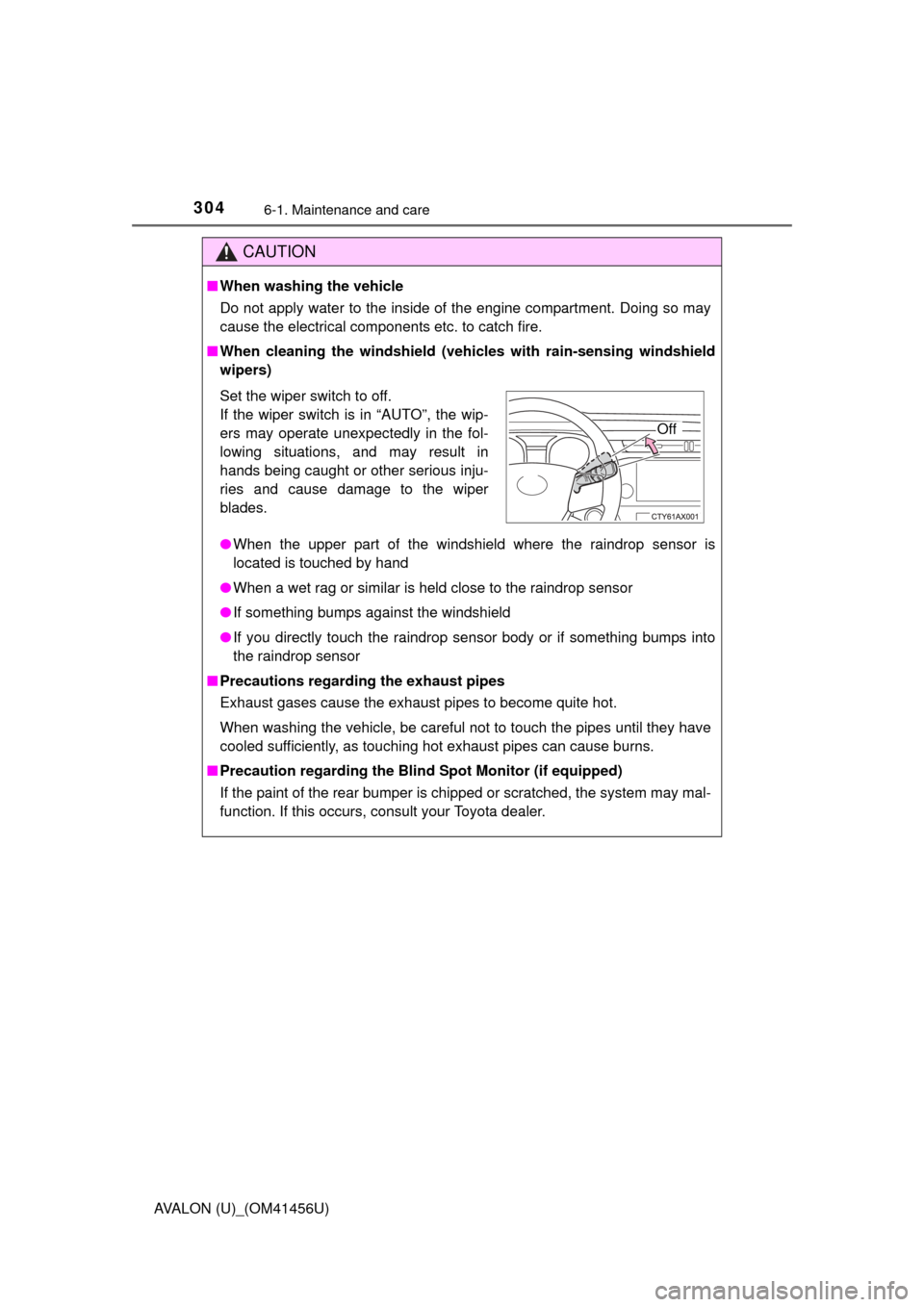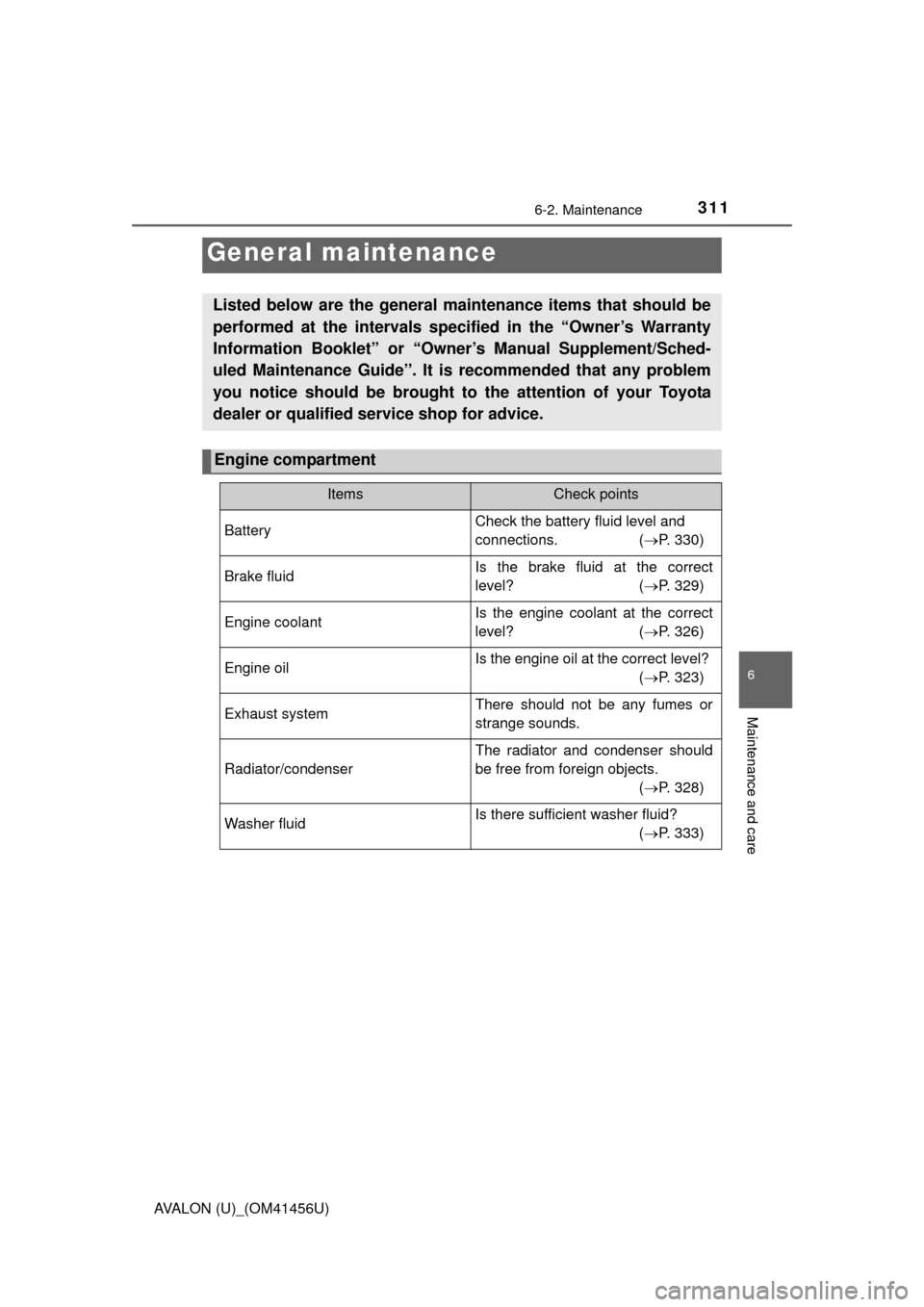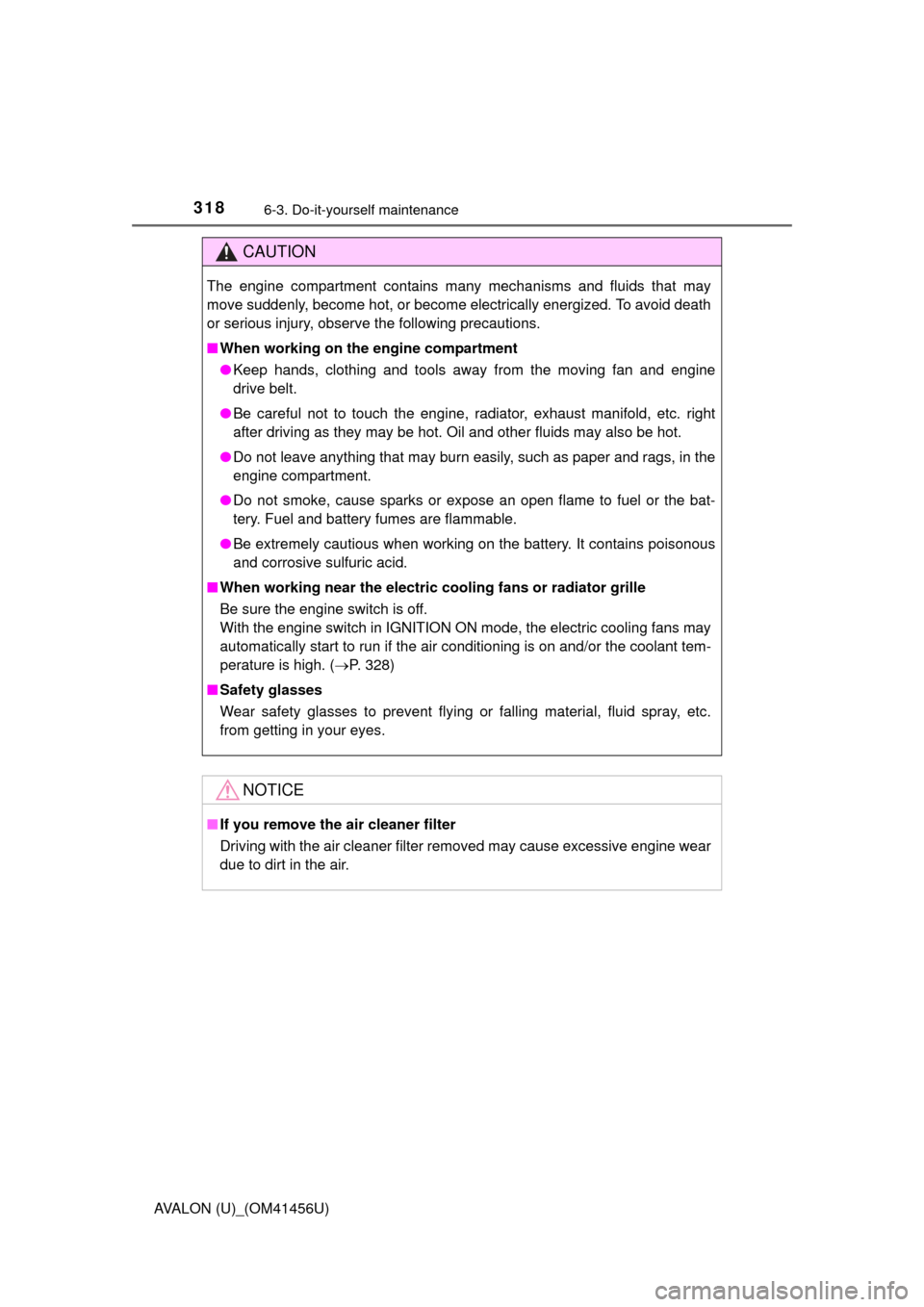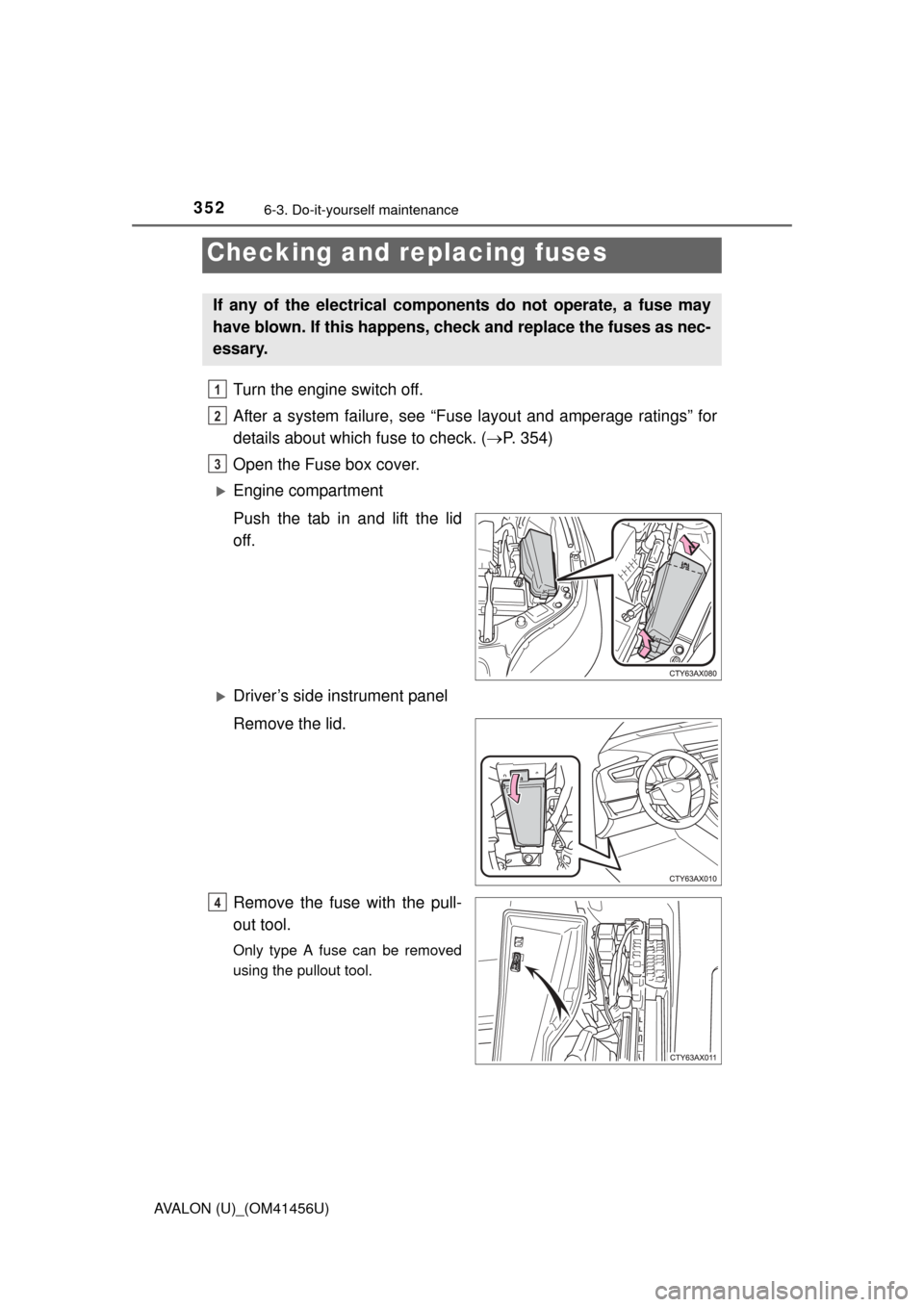2015 TOYOTA AVALON engine compartment
[x] Cancel search: engine compartmentPage 5 of 500

5
1
8 7
6
5
4
3
2
9
AVALON (U)_(OM41456U)6-1. Maintenance and care
Cleaning and protecting the vehicle exterior .......... 302
Cleaning and protecting the vehicle interior ........... 306
6-2. Maintenance Maintenance requirements ................... 309
General maintenance ........ 311
Emission inspection and maintenance (I/M)
programs ......................... 315
6-3. Do-it-yourself maintenance
Do-it-yourself service precautions ..................... 316
Hood.................................. 319
Positioning a floor jack ...... 320
Engine compartment ......... 322
Tires .................................. 334
Tire inflation pressure........ 342
Wheels .............................. 345
Air conditioning filter .......... 348
Electronic key battery ........ 350
Checking and replacing fuses ................ 352
Light bulbs ......................... 361 7-1. Essential information
Emergency flashers ........... 380
If your vehicle has to be stopped in an
emergency....................... 381
7-2. Steps to take in an emergency
If your vehicle needs to be towed ...................... 382
If you think something is wrong............................... 386
Fuel pump shut off system ............................. 387
If a warning light turns on or a warning
buzzer sounds ................. 388
If a warning message is displayed ......................... 399
If you have a flat tire .......... 400
If the engine will not start ........................... 413
If the shift lever cannot be shifted from P ............. 415
If the electronic key does not operate properly ........ 416
If the vehicle battery is discharged ....................... 419
If your vehicle overheats......................... 423
If the vehicle becomes stuck ................................ 426
6Maintenance and care7When trouble arises
Page 105 of 500

1053-2. Opening, closing and locking the doors
3
Operation of each component
AVALON (U)_(OM41456U)■
When the vehicle is not driven for extended periods
●To prevent theft of the vehicle, do not leave the electronic key within 6 ft. (2
m) of the vehicle.
● The smart key system can be deactivated in advance. ( P. 455)
■ Alarm
Using the smart key system to lock the doors will set the alarm system.
(P. 68)
■ To operate the system properly
●Make sure to carry the electronic key when operating the system. Do not get
the electronic key too close to the vehicle when operating the system from
the outside of the vehicle.
Depending on the position and holding condition of the electronic key, the
key may not be detected correctly and the system may not operate prop-
erly. (The alarm may go off accidentally, or the door lock prevention function
may not operate.)
● Do not leave the electronic key inside the luggage compartment.
The key confinement prevention function may not operate, depending on
the location of the key (close to a spare tire, the inside edge of the luggage
compartment), conditions (inside a metal bag, close to metallic objects) and
the radio waves in the surrounding area. ( P. 115)
■ If the smart key system do es not operate properly
● Locking and unlocking the doors: Use the mechanical key. ( P. 416)
● Unlocking the trunk: P. 1 1 6
● Starting the engine: P. 417
Page 217 of 500

2174-5. Using the driving support systems
4
Driving
AVALON (U)_(OM41456U)
■Turning off both TRAC/VSC systems
To turn the TRAC/VSC systems off, press and hold the switch for more than 3
seconds while the vehicle is stopped.
The VSC OFF and “TRAC OFF” indica tor lights will come on and the mes-
sage will be shown on the multi-information display.
Press the switch again to turn the systems back on.
■ When the message is displayed on th e multi-information display show-
ing that TRAC has been disabled and “TRAC OFF” indicator light comes
on even if the TRAC/VSC OFF switch has not been pressed
TRAC cannot be operated. Contact your Toyota dealer.
■ Sounds and vibrations caused by the ABS, brake assist, VSC and TRAC
systems
● A sound may be heard from the engine compartment when the brake pedal
is depressed repeatedly, when the engine is started or just after the vehicle
begins to move. This sound does not indicate that a malfunction has
occurred in any of these systems.
● Any of the following conditions may occur when the above systems are
operating. None of these indicates that a malfunction has occurred.
• Vibrations may be felt through the vehicle body and steering.
• A motor sound may be heard after the vehicle comes to a stop.
• The brake pedal may pulsate slightly after the ABS is activated.
• The brake pedal may move down slightly after the ABS is activated.
■ EPS operation sound
When the steering wheel is operated, a motor sound (whirring sound) may be
heard. This does not indicate a malfunction.
■ Automatic reactivation of TRAC and VSC systems
After turning the TRAC and VSC systems off, the systems will be automati-
cally re-enabled in the following situations:
● When the engine switch is turned off
● If only the TRAC system is turned off, the TRAC will turn on when vehicle
speed increases
If both the TRAC and VSC systems are turned off, automatic re-enabling will
not occur when vehicle speed increases.
■ Reduced effectiveness of the EPS system
The effectiveness of the EPS system is reduced to prevent the system from
overheating when there is frequent steering input over an extended period of
time. The steering wheel may feel heavy as a result. Should this occur, refrain
from excessive steering input or stop the vehicle and turn the engine off. The
effectiveness of the EPS system will be restored after a short while.
Page 301 of 500

301
Maintenance and care6
AVALON (U)_(OM41456U)6-1. Maintenance and care
Cleaning and protecting the vehicle exterior .......... 302
Cleaning and protecting the vehicle interior ........... 306
6-2. Maintenance Maintenance requirements ................... 309
General maintenance........ 311
Emission inspection and maintenance (I/M)
programs......................... 315
6-3. Do-it-yourself maintenance
Do-it-yourself service precautions ..................... 316
Hood ................................. 319
Positioning a floor jack ...... 320
Engine compartment ......... 322
Tires .................................. 334
Tire inflation pressure ....... 342
Wheels .............................. 345
Air conditioning filter.......... 348
Electronic key battery........ 350
Checking and replacing fuses ............................... 352
Light bulbs......................... 361
Page 304 of 500

3046-1. Maintenance and care
AVALON (U)_(OM41456U)
CAUTION
■When washing the vehicle
Do not apply water to the inside of the engine compartment. Doing so may
cause the electrical components etc. to catch fire.
■ When cleaning the windshield (veh icles with rain-sensing windshield
wipers)
● When the upper part of the windshi eld where the raindrop sensor is
located is touched by hand
● When a wet rag or similar is held close to the raindrop sensor
● If something bumps against the windshield
● If you directly touch the raindrop sensor body or if something bumps into
the raindrop sensor
■ Precautions regarding the exhaust pipes
Exhaust gases cause the exhaust pipes to become quite hot.
When washing the vehicle, be careful not to touch the pipes until they have
cooled sufficiently, as touching hot exhaust pipes can cause burns.
■ Precaution regarding the Blind Spot Monitor (if equipped)
If the paint of the rear bumper is chipped or scratched, the system may mal-
function. If this occurs, consult your Toyota dealer.
Set the wiper switch to off.
If the wiper switch is in “AUTO”, the wip-
ers may operate unexpectedly in the fol-
lowing situations, and may result in
hands being caught or other serious inju-
ries and cause damage to the wiper
blades.
Off
Page 311 of 500

3116-2. Maintenance
6
Maintenance and care
AVALON (U)_(OM41456U)
General maintenance
Listed below are the general maintenance items that should be
performed at the intervals specified in the “Owner’s Warranty
Information Booklet” or “Owner’s Manual Supplement/Sched-
uled Maintenance Guide”. It is recommended that any problem
you notice should be brought to the attention of your Toyota
dealer or qualified service shop for advice.
Engine compartment
ItemsCheck points
BatteryCheck the battery fluid level and
connections. ( P. 330)
Brake fluidIs the brake fluid at the correct
level? (P. 329)
Engine coolantIs the engine coolant at the correct
level? (P. 326)
Engine oilIs the engine oil at the correct level?
(P. 323)
Exhaust systemThere should not be any fumes or
strange sounds.
Radiator/condenser
The radiator and condenser should
be free from foreign objects.
(P. 328)
Washer fluidIs there sufficient washer fluid?
(P. 333)
Page 318 of 500

3186-3. Do-it-yourself maintenance
AVALON (U)_(OM41456U)
CAUTION
The engine compartment contains many mechanisms and fluids that may
move suddenly, become hot, or become electrically energized. To avoid death
or serious injury, observe the following precautions.
■When working on the engine compartment
● Keep hands, clothing and tools away from the moving fan and engine
drive belt.
● Be careful not to touch the engine, radiator, exhaust manifold, etc. right
after driving as they may be hot. Oil and other fluids may also be hot.
● Do not leave anything that may burn easily, such as paper and rags, in the
engine compartment.
● Do not smoke, cause sparks or expose an open flame to fuel or the bat-
tery. Fuel and battery fumes are flammable.
● Be extremely cautious when working on the battery. It contains poisonous
and corrosive sulfuric acid.
■ When working near the electric cooling fans or radiator grille
Be sure the engine switch is off.
With the engine switch in IGNITION ON mode, the electric cooling fans may
automatically start to run if the air conditioning is on and/or the coolant tem-
perature is high. ( P. 328)
■ Safety glasses
Wear safety glasses to prevent flying or falling material, fluid spray, etc.
from getting in your eyes.
NOTICE
■If you remove the air cleaner filter
Driving with the air cleaner filter removed may cause excessive engine wear
due to dirt in the air.
Page 352 of 500

3526-3. Do-it-yourself maintenance
AVALON (U)_(OM41456U)
Turn the engine switch off.
After a system failure, see “Fuse layout and amperage ratings” for
details about which fuse to check. ( P. 354)
Open the Fuse box cover.
Engine compartment
Push the tab in and lift the lid
off.
Driver’s side instrument panel
Remove the lid.
Remove the fuse with the pull-
out tool.
Only type A fuse can be removed
using the pullout tool.
Checking and replacing fuses
If any of the electrical components do not operate, a fuse may
have blown. If this happens, check and replace the fuses as nec-
essary.
1
2
3
4